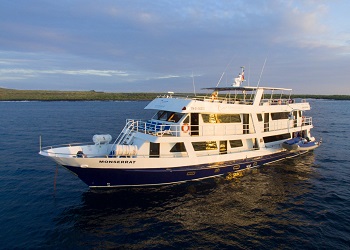Darwin Itinerary Adventure - 5 Days
ITINERARY B - 5 DAYS
SUNDAY
AM: Baltra Arrival and Transfer to the boat
PM: Highlands (HK)
MONDAY
AM: Isabela: Tintoreras (HK/SN)
PM: Isabela: Breeding Center/ Humedales /wall of tears (HK)
TUESDAY
AM: Rabida (HK/SN)
PM: Santa Cruz: Dragon Hill (HK)
WEDNESDAY
AM: Santa Cruz: Black Turtle Cove (SN)
PM: Chinese Hat (HK/SN)
THURSDAY
AM: Daphne (HK/SN)
The Tour ends at Seymor. You must take the Lobito bus in the direction of Baltra Airport.
HK: HIKE / SN: SNORKEL / PR: PANGA RIDE / KY: KAYAK /
PB: PADDLE BOARD
DAY 1: THURSDAY
AM: BALTRA ARRIVAL AND TRANSFER TO THE BOAT
After landing in Santa Cruz, go through an inspection point to prevent the introduction of foreign plants and animals.
Your guide will meet you at the airport, help with your luggage, and take you to the bus for the ferry across the Itabaca Channel.
PM: SANTA CRUZ: HIGHLANDS
You’ll learn about the vegetation and animal life of this zone, often strikingly different than that found at lower elevations and our best opportunity to find the famous giant tortoises in their natural habitat. Darwin’s Finches, Yellow Warblers, and other land birds will fly in and out of the moss-covered trees. From this high vantage point you’ll be treated to beautiful views of the island.
In the late afternoon you’ll return to town. For those who wish to check out the nightlife, this is your chance; the boat will be docked in port most of the night.
DAY 2: MONDAY
AM: ISABELA: TINTORERAS
Early in the morning, visit to Las Tintoreras, a group of small islets about 900 meters long filled with amazing wildlife like marine iguanas, blue-footed boobies, sea-lions, marine turtles, sharks; sea waters are calm and clear most of the year which guarantees that you will spot many marine species,
PM: ISABELA: WALLS OF TEARS - TORTOISE CENTER.
After Lunch, We will visit a very special location on the Highlands of Isabela to visit a wonderful Tortoise Farm & Research Center where you will walk around Giant Tortoises in semi-wild state while learning about the efforts of the National Park to protect these fantastic animals,
DAY 3: TUESDAY
AM: RABIDA ISLAND
Rábida Island stands out for its red rocks and sand. The volcanic material here is porous, changing color due to oxidation. A short trail leads to a lagoon where you can see land birds and a colony of flamingos. It is interesting to observe the pelicans diving in for fish. The red beach contrasts with the green vegetation.
Snorkeling is amongst the best as you swim along the coastline, playful sea lions join you. You can spot moray eels, small sharks, starfish and lots of colorful fish.
PM: SANTA CRUZ: DRAGON HILL
After this visit you’ll navigate for a couple of hours to Dragon Hill, where you’ll make a dry landing on lava rocks. Dragon Hill is a small bay on the west coast of Santa Cruz and got its name from the many land iguanas that live in the area. Land iguanas are endemic to the Galapagos Islands where they have found good mating and nesting areas.
DAY 4: WEDNESDAY
AM: SANTA CRUZ: BLACK TURTLE COVE
Black Turtle Cove, is a red mangrove lagoon on Santa Cruz and is a nursery for many sharks and rays. It’s also a great location to observe mating turtles around this time of year. You might see a large groups of resting White-Tip Reef Sharks, schools of Golden Rays and Spotted Eagle Rays, and a few juvenile Scalloped Hammerhead Sharks and Black-Tip Sharks. The water very calm so we often used paddles instead of the loud panga engines to move around the area.
PM: CHINESE HAT
Chinese Hat is a small islet off Santiago Island’s southeastern tip. This recent volcanic cone resembles a Chinese hat. Explore lava formations and observe sea lion colonies, lava lizards, marine iguanas, and Galapagos penguins. This is an island of colorful contrasts, the red vessuvium flowers, the sally lightfoot crabs and the orange beaks of the American oystercatchers contrast beautifully with the pahoe hoe lava fields and lava cacti.
It is also a nice spot for deep water snorkeling, the channel formed between Sombrero Chino and Santiago island creates are protected area with calm turquoise waters, yet deep enough to attract white-tipped reef sharks that sleep in the small caves formed below. You can also observe sting rays, parrot fish, Galapagos penguins, marine turtles and with luck dolphins and the rare visit of a whale-sharks.
DAY 5: THURSDAY
AM: DAPHNE / BALTRA TRANSFER TO THE AIRPORT
Circumnavigation. Breakfast service. Check out and airport departure.
Among the central islands of the Galapagos Archipelago, Daphne Island sits north of Santa Cruz Island and west of Baltra Island. In reality there are two islands: Daphne Major and Daphne Minor. They are one of the more accessible Galapagos Islands and are easily reached by most tour boats and cruises. Please note that disembarkation on these islands is not possible, therefore we will sail around them for one last look at the beautiful vistas of Galapagos.







